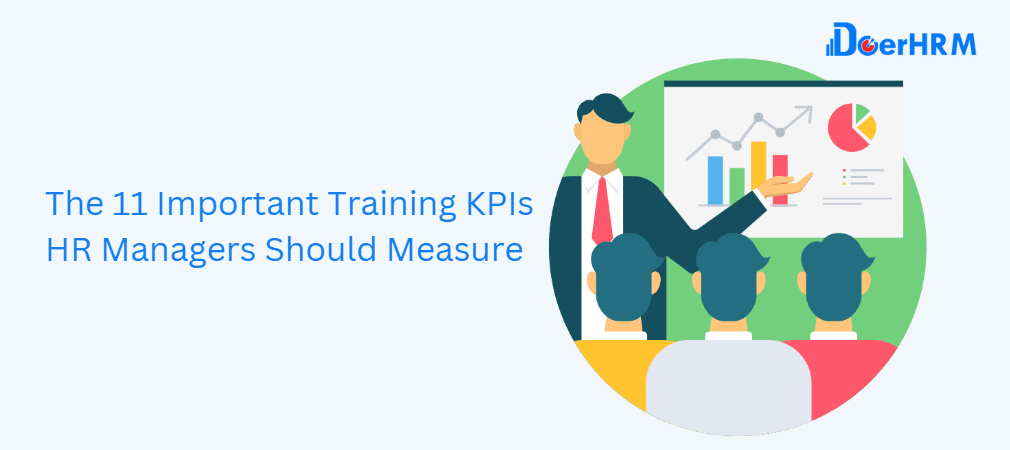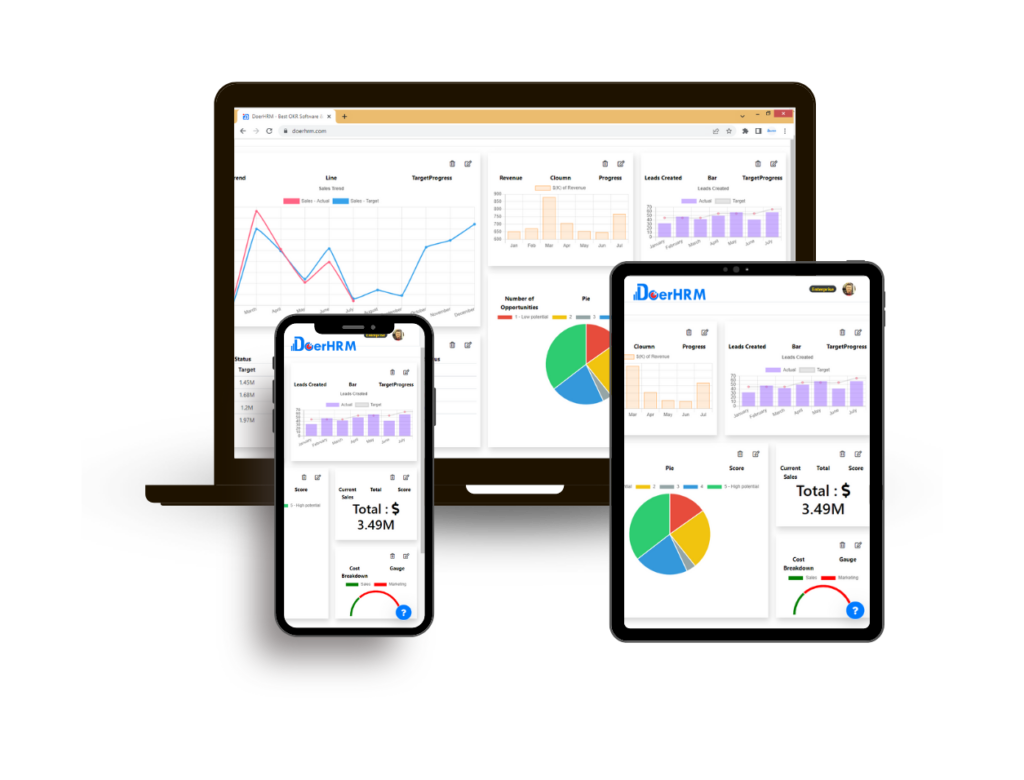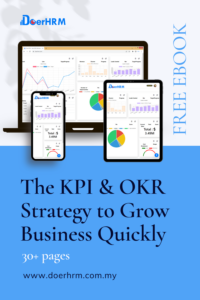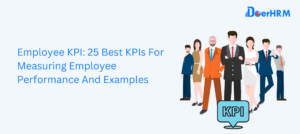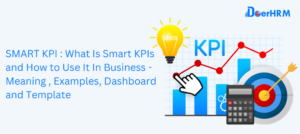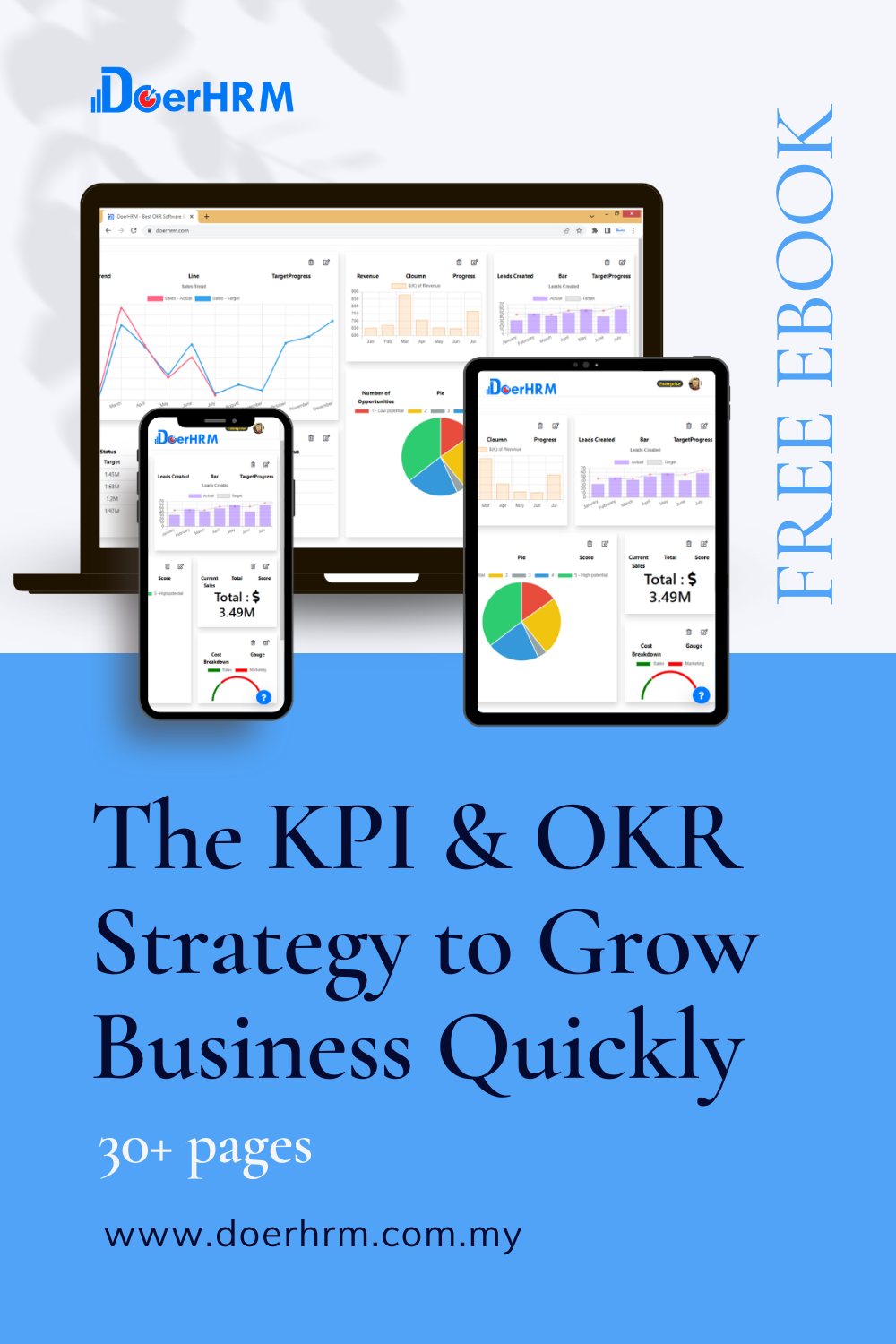KPIs, or key performance indicators, are measurable metrics used to evaluate the effectiveness and success of an organization or department in achieving its goals and objectives. When it comes to training, HR managers should measure a variety of KPIs to ensure that their training programs are effective in helping employees acquire new skills and knowledge and that these skills are being applied to their job responsibilities.
Here are the 11 most important KPIs for training that every HR manager should measure:
- Training ROI (Return on Investment)
- Training completion rate
- Time to competency
- Employee engagement
- Skill development
- Manager satisfaction
- Employee retention
- Knowledge retention
- Employee performance
- Learning effectiveness
- Training effectiveness
Training ROI (Return on Investment)
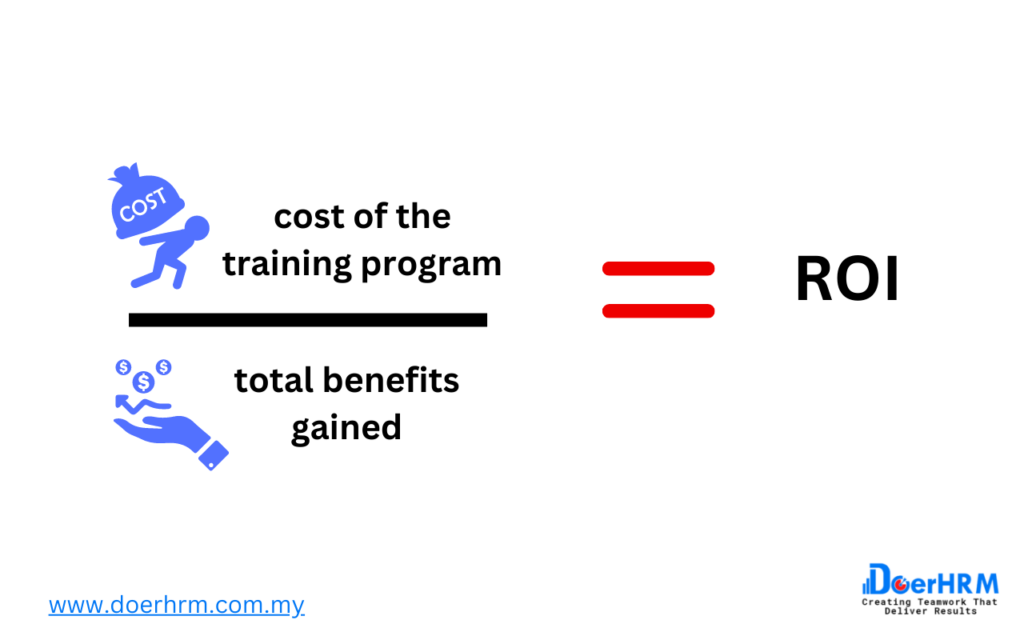
Training ROI (Return on Investment) is a key performance indicator (KPI) that measures the financial return on investment from training programs. This metric allows HR managers to evaluate the effectiveness of training programs by comparing the cost of the training to the benefits gained by the organization.
To calculate training ROI, the total cost of the training program is divided by the total benefits gained. The benefits can be measured in a variety of ways, such as increased revenue, improved productivity, reduced turnover, and enhanced customer satisfaction.
For example, if a company spends $50,000 on a training program that results in a $100,000 increase in revenue, the training ROI would be 100 percent ($100,000 – $50,000 = $50,000 / $50,000 x 100% = 100%). A positive ROI indicates that the benefits of the training program outweigh the cost, while a negative ROI indicates that the cost of the training program exceeded the benefits gained.
Training ROI can help HR managers to make data-driven decisions about training investments, prioritize training programs, and identify areas for improvement in the training process. By tracking training ROI over time, HR managers can also measure the impact of training on the organization’s bottom line and demonstrate the value of training to senior leadership.
Related: What is a Key Performance Indicator (KPI)? Meaning, Templates, Examples
Training completion rate
Training completion rate is a key performance indicator (KPI) that measures the percentage of employees who have successfully completed a particular training program. This metric allows HR managers to evaluate the effectiveness of training programs by assessing how many employees have completed the training and how many have not.
The training completion rate is calculated by dividing the number of employees who have completed the training by the total number of employees who were expected to complete the training. For example, if 100 employees were expected to complete a training program and 80 employees actually completed the program, the training completion rate would be 80%.
A high training completion rate is generally indicative of a successful training program, as it suggests that employees have found the training engaging and relevant, and have completed it in a timely manner. Conversely, a low training completion rate may indicate that the training is not meeting the needs of employees or that there are barriers preventing employees from completing the training, such as a lack of time or resources.
By tracking training completion rates over time, HR managers can identify trends and areas for improvement in the training process, and adjust the training program accordingly. For example, if the completion rate for a particular training program is consistently low, HR managers may need to reassess the training content, delivery method, or scheduling to increase employee engagement and participation.
Related: Proven Methods To Improve Employee Engagement
Time to competency
Time to competency is a key performance indicator (KPI) that measures how long it takes for employees to become fully proficient in their job duties after completing a training program. This metric allows HR managers to assess the effectiveness of training programs in terms of how quickly employees are able to apply their newly acquired skills and knowledge to their job responsibilities.
The time to competency is typically measured as the length of time between the completion of a training program and the point at which an employee is deemed fully proficient in their job duties. The specific criteria for determining competency may vary depending on the organization and job role, but typically involve a set of defined skills or performance standards.
A shorter time to competency generally indicates a more effective training program, as it suggests that employees are able to apply their new skills and knowledge to their job responsibilities quickly and efficiently. Conversely, a longer time to competency may indicate that the training program was not effective in preparing employees for their job duties or that additional support or resources are needed to help employees apply their new skills and knowledge.
By tracking time to competency over time, HR managers can identify trends and areas for improvement in the training process, and adjust the training program accordingly. For example, if the time to competency for a particular training program is consistently long, HR managers may need to reassess the training content or delivery method to ensure that employees are better prepared to apply their new skills and knowledge to their job responsibilities.
Related article : Top 20 HR KPI Metrics & Examples for Human Resource Manager, Executive, Department – HRMS
Employee engagement
Employee engagement is a key performance indicator (KPI) that measures the level of involvement, enthusiasm, and commitment that employees have towards their job and the organization. This metric allows HR managers to assess the effectiveness of training programs in terms of how they impact employee motivation, job satisfaction, and overall engagement.
Employee engagement is typically measured through surveys or other feedback mechanisms that gather employee perceptions and opinions about their work environment, job duties, and organizational culture. The specific questions and metrics used may vary depending on the organization and job role, but typically involve factors such as employee satisfaction, communication, recognition, and opportunities for growth and development.
A high level of employee engagement is generally indicative of a positive work environment and effective training programs, as it suggests that employees are motivated and committed to their job and the organization. Conversely, a low level of employee engagement may indicate that there are issues with the work environment, job duties, or training programs that are negatively impacting employee motivation and satisfaction.
By tracking employee engagement over time, HR managers can identify trends and areas for improvement in the training process, and adjust the training program accordingly. For example, if employee engagement scores are consistently low, HR managers may need to reassess the training content or delivery method to ensure that employees are more engaged and motivated to apply their new skills and knowledge to their job responsibilities. Additionally, HR managers may need to address broader issues with the work environment or organizational culture to improve employee engagement and job satisfaction.
Related article : Sales KPI: 28 Metrics for Sales Manager – Examples, Meaning, Template, Dashboard
Skill development
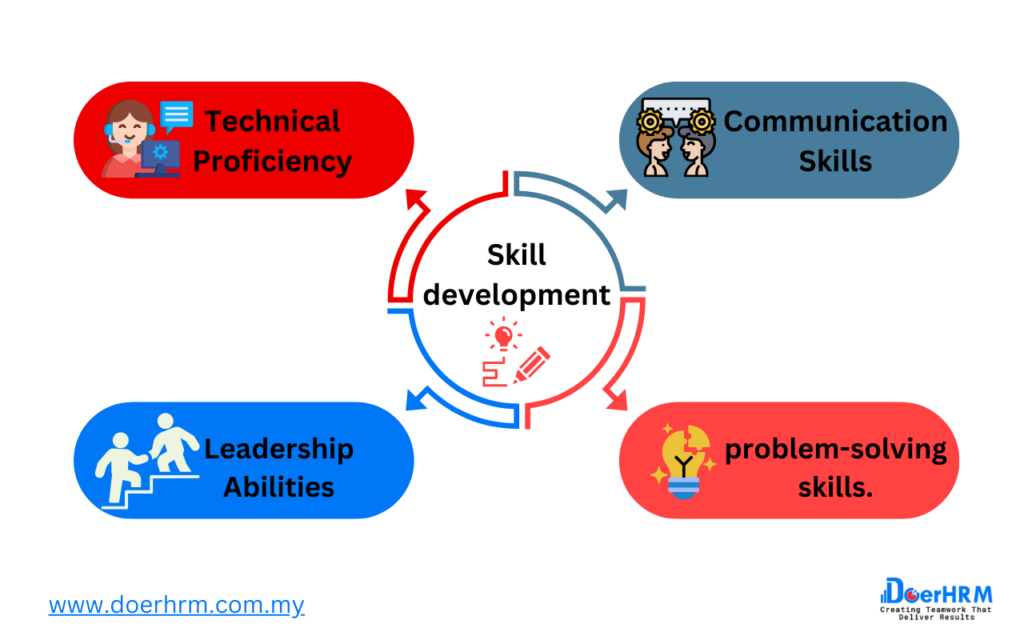
Skill development is a key performance indicator (KPI) that measures the extent to which employees are able to develop new skills or improve existing skills through training programs. This metric allows HR managers to assess the effectiveness of training programs in terms of how they impact employee skill sets and the organization’s ability to meet its goals and objectives.
Skill development is typically measured through a variety of methods, such as skills assessments, performance reviews, and feedback from managers and colleagues. The specific skills and competencies measured may vary depending on the organization and job role, but typically involve factors such as technical proficiency, communication skills, leadership abilities, and problem-solving skills.
A high level of skill development is generally indicative of effective training programs, as it suggests that employees are able to apply their new skills and knowledge to their job responsibilities and contribute to the organization’s success. Conversely, a low level of skill development may indicate that the training programs are not effective in helping employees acquire new skills or that there are barriers preventing employees from applying their new skills and knowledge to their job responsibilities.
By tracking skill development over time, HR managers can identify trends and areas for improvement in the training process, and adjust the training program accordingly. For example, if employees are consistently struggling to apply their new skills and knowledge to their job responsibilities, HR managers may need to reassess the training content or delivery method to ensure that the training program is effectively preparing employees for their job duties. Additionally, HR managers may need to provide additional support or resources to help employees apply their new skills and knowledge to their job responsibilities.
Related article : Why KPIs Are Important: 10 Reason Key Performance Indicators Stands For? -Meaning, Examples ,Template
Manager satisfaction
Manager satisfaction is a key performance indicator (KPI) that measures the satisfaction levels of managers with respect to the training and development programs offered to their team members. This metric allows HR managers to assess the effectiveness of training programs in terms of their impact on managers’ ability to develop and retain their team members.
Manager satisfaction is typically measured through surveys or other feedback mechanisms that gather manager perceptions and opinions about the training programs offered to their team members. The specific questions and metrics used may vary depending on the organization and job role, but typically involve factors such as the relevance and effectiveness of the training programs, the quality of the training materials and delivery, and the impact of the training programs on team member performance and productivity.
A high level of manager satisfaction is generally indicative of effective training programs, as it suggests that managers are able to effectively develop and retain their team members, and that the training programs are aligned with the organization’s goals and objectives. Conversely, a low level of manager satisfaction may indicate that there are issues with the training programs that are negatively impacting manager’s ability to develop and retain their team members.
By tracking manager satisfaction over time, HR managers can identify trends and areas for improvement in the training process, and adjust the training program accordingly. For example, if manager satisfaction scores are consistently low, HR managers may need to reassess the training content or delivery method to ensure that the training program is effectively preparing team members for their job duties and helping managers to develop and retain their team members. Additionally, HR managers may need to provide additional support or resources to help managers effectively implement the training programs with their team members.
Related article : Why KPIs Are Important: 10 Reason Key Performance Indicators Stands For? -Meaning, Examples ,Template
Employee retention
Employee retention is a key performance indicator (KPI) that measures the extent to which employees are staying with the organization over time. This metric allows HR managers to assess the effectiveness of training programs in terms of their impact on employee job satisfaction, career development, and overall commitment to the organization.
Employee retention is typically measured by calculating the percentage of employees who remain with the organization over a specified period of time, such as a year or a quarter. The specific factors that contribute to employee retention may vary depending on the organization and job role, but typically involve factors such as job satisfaction, career advancement opportunities, compensation and benefits, and work-life balance.
A high level of employee retention is generally indicative of a positive work environment and effective training programs, as it suggests that employees are satisfied with their job duties, career development opportunities, and overall compensation and benefits package. Conversely, a low level of employee retention may indicate that there are issues with the work environment, job duties, or training programs that are negatively impacting employee job satisfaction and commitment to the organization.
By tracking employee retention over time, HR managers can identify trends and areas for improvement in the training process, and adjust the training program accordingly. For example, if employee retention rates are consistently low, HR managers may need to reassess the training content or delivery method to ensure that the training program is effectively preparing employees for their job duties and providing them with the skills and knowledge they need to advance in their careers within the organization. Additionally, HR managers may need to address broader issues with the work environment or organizational culture to improve employee job satisfaction and commitment to the organization.
Related: Why Employee Retention Is Important
Knowledge retention
Knowledge retention is a key performance indicator (KPI) that measures the extent to which employees are able to retain and apply the knowledge and skills they have acquired through training programs over time. This metric allows HR managers to assess the effectiveness of training programs in terms of their impact on employee performance and productivity.
Knowledge retention is typically measured through assessments or evaluations that test employee knowledge and skills before and after a training program. The specific knowledge and skills measured may vary depending on the organization and job role, but typically involve factors such as technical proficiency, communication skills, problem-solving abilities, and leadership skills.
A high level of knowledge retention is generally indicative of effective training programs, as it suggests that employees are able to apply the knowledge and skills they have acquired through training programs to their job duties and contribute to the organization’s success over time. Conversely, a low level of knowledge retention may indicate that the training programs are not effective in helping employees acquire new skills or that employees are not applying their new skills and knowledge to their job responsibilities.
By tracking knowledge retention over time, HR managers can identify trends and areas for improvement in the training process, and adjust the training program accordingly. For example, if employees are consistently struggling to retain and apply the knowledge and skills they have acquired through training programs, HR managers may need to reassess the training content or delivery method to ensure that the training program is effectively preparing employees for their job duties and providing them with the skills and knowledge they need to succeed in their roles. Additionally, HR managers may need to provide additional support or resources to help employees apply their new skills and knowledge to their job responsibilities.
Related article : Marketing KPI: 25 Digital Marketing Key Performance Indicators for Sales & Marketing- Manager, Department, Examples
Employee performance
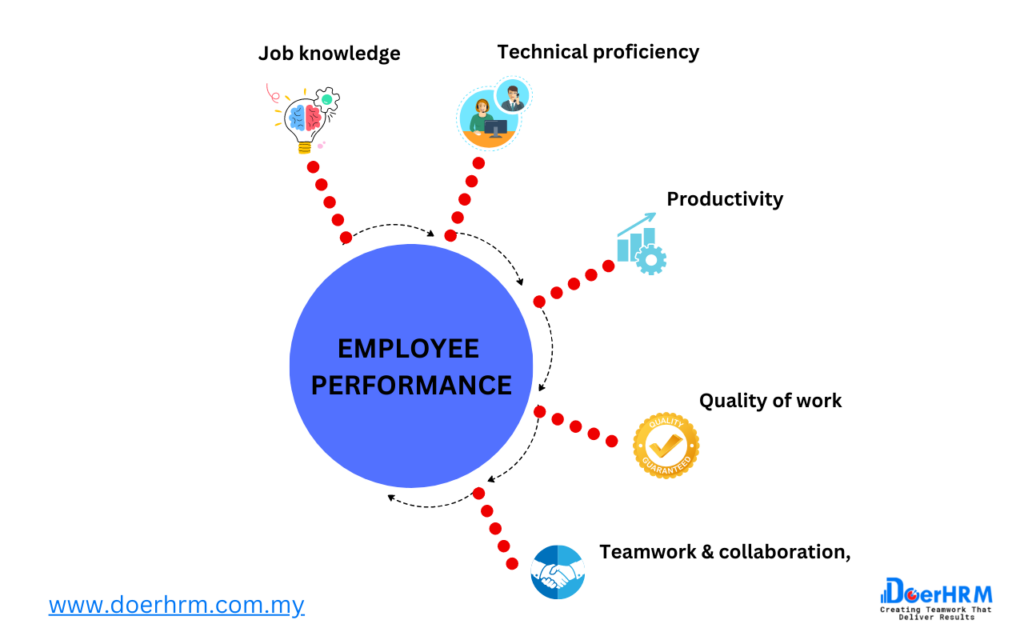
Employee performance is a key performance indicator (KPI) that measures the effectiveness of employees in achieving their job responsibilities and contributing to the organization’s goals and objectives. This metric allows HR managers to assess the effectiveness of training programs in terms of their impact on employee job performance and productivity.
Employee performance is typically measured through a variety of methods, such as supervisor evaluations, self-assessments, and performance metrics. The specific performance factors measured may vary depending on the organization and job role, but typically involve factors such as job knowledge, technical proficiency, productivity, quality of work, teamwork and collaboration, and adherence to organizational policies and procedures.
A high level of employee performance is generally indicative of effective training programs, as it suggests that employees are able to apply the knowledge and skills they have acquired through training programs to their job duties and contribute to the organization’s success. Conversely, low employee performance may indicate that there are issues with the training programs, job design, or employee engagement that are negatively impacting employee job performance and productivity.
By tracking employee performance over time, HR managers can identify trends and areas for improvement in the training process, and adjust the training program accordingly. For example, if employee performance metrics are consistently low, HR managers may need to reassess the training content or delivery method to ensure that the training program is effectively preparing employees for their job duties and providing them with the skills and knowledge they need to succeed in their roles. Additionally, HR managers may need to address broader issues with the work environment, job design, or organizational culture to improve employee job satisfaction and motivation, which can have a positive impact on employee performance.
Related article : IT KPI : 25 Key Performance Indicator for IT Managers – Meaning ,Dashboard and Examples
Learning effectiveness
Learning effectiveness is a key performance indicator (KPI) that measures the effectiveness of training programs in terms of their impact on employee knowledge and skills acquisition. This metric allows HR managers to assess the effectiveness of training programs in terms of their impact on employee performance and productivity.
Learning effectiveness is typically measured through a variety of methods, such as pre- and post-training assessments, evaluations, and feedback surveys. The specific learning factors measured may vary depending on the organization and job role, but typically involve factors such as knowledge acquisition, skill development, and behavior change.
A high level of learning effectiveness is generally indicative of effective training programs, as it suggests that employees are able to acquire new knowledge and skills and apply them to their job responsibilities. Conversely, low learning effectiveness may indicate that the training programs are not effective in helping employees acquire new skills or that employees are not applying their new skills and knowledge to their job responsibilities.
By tracking learning effectiveness over time, HR managers can identify trends and areas for improvement in the training process, and adjust the training program accordingly. For example, if learning effectiveness metrics are consistently low, HR managers may need to reassess the training content or delivery method to ensure that the training program is effectively preparing employees for their job duties and providing them with the skills and knowledge they need to succeed in their roles. Additionally, HR managers may need to provide additional support or resources to help employees apply their new skills and knowledge to their job responsibilities.
Related article : SMART KPI : What Is Smart KPIs and How to Use It In Business – Meaning , Examples, Dashboard and Template
Training effectiveness
Training effectiveness is a key performance indicator (KPI) that measures the effectiveness of training programs in terms of their overall impact on employee performance and productivity. This metric allows HR managers to assess the effectiveness of training programs in achieving their intended goals and objectives.
Training effectiveness is typically measured through a variety of methods, such as pre- and post-training assessments, evaluations, and feedback surveys. The specific training factors measured may vary depending on the organization and job role, but typically involve factors such as knowledge acquisition, skill development, behavior change, employee engagement, and business outcomes.
A high level of training effectiveness is generally indicative of effective training programs, as it suggests that the training program is successfully preparing employees for their job duties and providing them with the skills and knowledge they need to succeed in their roles. Additionally, a highly effective training program can positively impact employee engagement, motivation, and retention, leading to improved business outcomes.
Conversely, low training effectiveness may indicate that the training programs are not effective in helping employees acquire new skills or that employees are not applying their new skills and knowledge to their job responsibilities. This can lead to decreased employee performance and productivity, as well as negative impacts on employee engagement and retention.
By tracking training effectiveness over time, HR managers can identify trends and areas for improvement in the training process, and adjust the training program accordingly. For example, if training effectiveness metrics are consistently low, HR managers may need to reassess the training content or delivery method to ensure that the training program is effectively preparing employees for their job duties and providing them with the skills and knowledge they need to succeed in their roles. Additionally, HR managers may need to provide additional support or resources to help employees apply their new skills and knowledge to their job responsibilities.
Related: KPI Training: Maximize Your Team’s Potential!
How KPI & OKR Performance Management Software helps HR Managers to measure KPIs for training
KPI and OKR performance management software can be extremely helpful for HR managers when it comes to measuring KPIs for training. Especially this DoerHRM software provides an automated and centralized platform to track, analyze and report on key performance indicators related to training programs, allowing HR managers to identify trends, patterns, and areas for improvement in the training process.
Here are some specific ways that DoerHRM software can help HR managers measure KPIs for training:
- Customizable dashboards: The software provides customizable dashboards that allow HR managers to visualize key performance indicators related to training programs in real-time. This helps them to easily monitor and track the progress of their training programs and make informed decisions based on data insights.
- Real-time reporting: The software generates real-time reports that provide a detailed analysis of training KPIs, including trends, patterns, and areas for improvement. This helps HR managers to identify what is working well and what needs to be improved in the training program.
- Goal-setting and tracking: The software allows HR managers to set and track goals for training programs based on specific KPIs, such as completion rates, time to competency, and employee engagement. This helps to align training goals with business objectives, and to ensure that the training program is having a positive impact on the organization.
- Collaborative goal-setting: The software allows HR managers to collaborate with employees and managers in setting and tracking training goals, which promotes engagement and buy-in from all stakeholders.
- Feedback and evaluation: The software provides tools for collecting feedback and evaluating the effectiveness of training programs. This helps HR managers to identify areas of strength and weakness in the training program, and to make adjustments as needed to improve its effectiveness.
Overall, DoerHRM software can help HR managers to streamline their training programs, track progress, and make data-driven decisions that improve the effectiveness of the training program. By leveraging these tools, HR managers can ensure that their training programs are having a positive impact on employee performance, engagement, and retention, and contributing to the overall success of the organization.
So why not take advantage of a free trial of DoerHRM software today? With a range of features designed to simplify the tracking and monitoring of your organization’s performance, you can save time, reduce errors, and achieve your business goals more efficiently.
Conclusion
By tracking these KPIs over time, HR managers can identify trends and areas for improvement in their training programs, and adjust the training program accordingly to ensure that it is effectively preparing employees for their job duties and providing them with the skills and knowledge they need to succeed in their roles.
